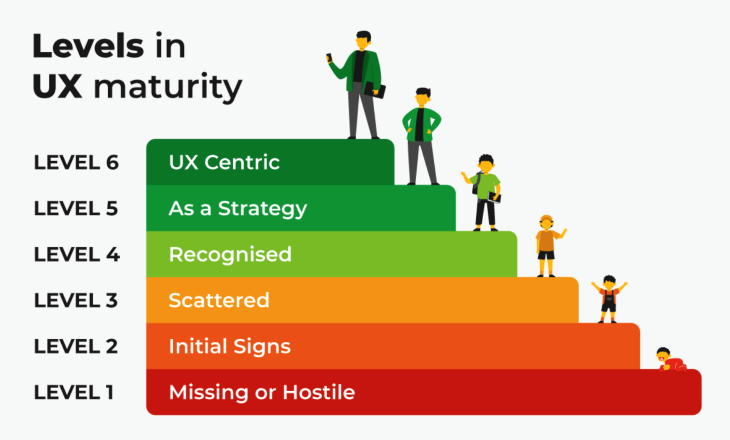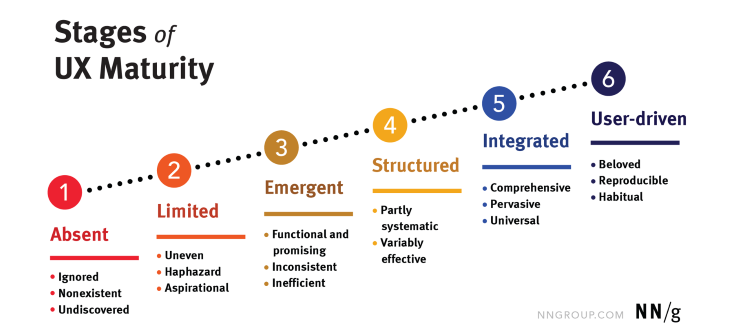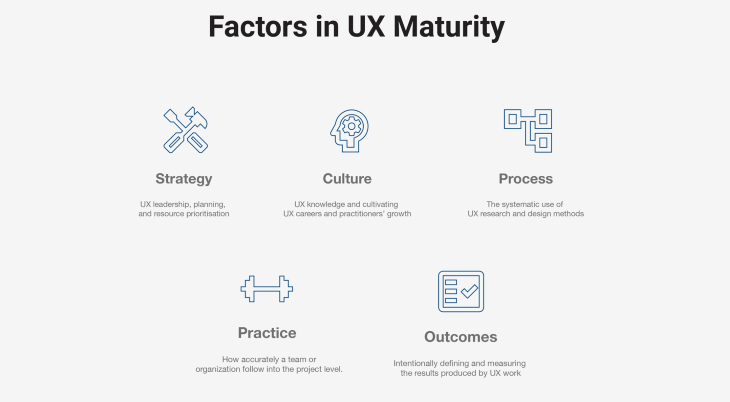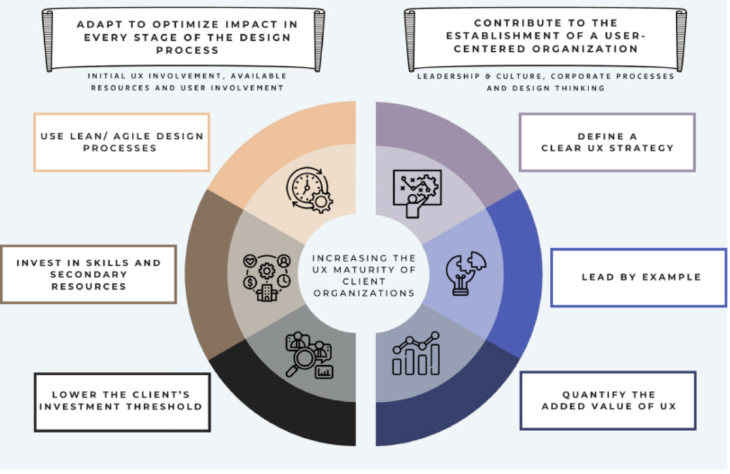UX maturity refers to an organization’s investment in and commitment to delivering user-centered solutions at every level of the company. Your UX maturity is important because understanding an organization’s maturity level enables teams to better integrate a user-centric approach into processes and structures across all departments and create a better experience for users.
But although having a good grasp of a company’s UX maturity level — and how to improve it — is beneficial for both employees and users, knowing how to identify it can be a challenge.
That’s where this article comes in.
In this post, we’re going to be explaining everything you need to know about UX maturity as well as how you can identify — and, if necessary, improve — your company’s UX maturity level.
Here’s a clickable list of the topics we’ll be covering:
- What do we mean by UX maturity?
- What are the different UX maturity stages?
- How to determine your company’s UX maturity stage
- Benefits of understanding your company’s UX maturity stage
- How to advance your company’s UX maturity level
- Common challenges companies face when advancing their UX maturity level
Ready to learn more? Then let’s go!

What do we mean by UX maturity?
The Nielsen Norman Group, leaders in user-centered design, defines UX maturity as “the measure of an organization’s desire and ability to successfully deliver user-centered design.”
Put simply, how much a company is willing to invest in and commit to UX design theory and implement it into both its everyday activities and its long term strategy will determine how mature that organization is in terms of UX design. It will also be a sure sign of how successfully that company attracts and retains its users.
When assessing a company’s UX maturity stage it can be helpful to use a recognized framework which describes the maturity of the business in relation to its adoption of UX best practices and methodologies.
Over the years, different frameworks have been created to help companies determine and describe their company’s commitment to and investment in UX, but for the purpose of this article, we’ll be following the framework of the Nielsen Norman Group, using the categories Absent, Limited, Emerging, Structured, Integrated, and User-driven.

What are the different UX maturity stages?
In order to be able to identify your company’s UX maturity stage, you’ll need to become familiar with the different UX maturity stages in which your organization’s practices, attitudes, methodologies, and philosophies might fall.
Absent
The first stage of UX maturity is pretty self-explanatory. If a UX approach is absent from a company’s ideology, that means it doesn’t exist at all. There is no work being undertaken relating to the user’s experience, usability, or creating a user-centric product or service. In fact, at this level there might even be organization-wide hostility towards such an approach.
To move up to the next level of UX maturity, an organization at the Absent level would need to slowly start fostering an awareness of UX.
Limited
At this stage, there is usually some recognition of the role of UX design within an organization, with some departments perhaps even taking on UX-related practices. However, in companies such as these, there is typically not a consistent approach to UX, and the efforts which are made can be erratic, purely experimental, or not seen through to fruition.
To move to the next level of UX maturity, companies at the Limited stage should promote the successes they’ve had with UX design to the rest of the company, particularly to company leaders who would have the authority to initiate a more company-wide UX-centered approach.
Emerging
At the Emerging stage of UX maturity, UX design work or best practices are encouraged or even implemented in multiple teams, with professionals potentially brought on board to oversee UX practices. However, the approach is typically still limited to specific departments and can be erratic. Rather than the implementation of an organization-wide, UX-focused initiative, UX-centered projects tend to be run by interested individuals. This can mean they sometimes lack the support needed from management to inform company policy with their learnings.
It’s not uncommon for companies to get stuck at this stage because once we achieve some small UX achievements, it’s easy to believe enough of a UX approach has been implemented.
To make more progress, companies at the Emerging stage need to begin piecing together the elements of UX they are currently working on and start building a more coherent structure and culture that promotes UX at every level of the organization.
Structured
Companies that have achieved the Structured level of UX maturity have succeeded in two key areas:
- They have recognized the importance of UX in helping them reach their overall business goals
- They have a dedicated UX design team in place
In addition, many Structured-level companies will be led by individuals who are positive about a UX design approach and even use it to make C-level decisions, on occasion.
Integrated
For an integrated-level company, UX-related activities will be performed on a daily basis by almost every team, while a UX-led approach will be used to meet business goals — and other important success metrics — company-wide. According to the Nielsen Norman Group, the UX approach at the Integrated level is both comprehensive and pervasive, and the company may even boast of employees contributing their own innovations and ideas to the general field of UX.
User-driven
Companies that are considered to be User-driven — the highest level of UX maturity — have created an environment within which UX is the norm: a beloved practice integrated into every level of the organization. Each employee has in-depth knowledge of user-centered design and its importance to the success of the company and the satisfaction of its users, while both high-level corporate strategy and everyday project management is driven by a need to fully comprehend the user’s motivations, goals, preferences, desires, and needs.
Although it’s quite rare to find a company that meets the criteria of the User-driven stage of UX maturity, those that do typically consist of individuals and teams who also contribute significantly to the field of UX itself.

How to determine your company’s UX maturity stage
There is no single method for determining your company’s level of UX maturity. However, what is crucial is that once you have decided upon a maturity scale, the whole team uses that same scale as their reference point.
A common first step in determining an organization’s stage of UX maturity is to perform an internal assessment looking at:
- Current UX practices
- Applied UX processes
- In-house UX practitioners and team
- Tools used
- Deliverables
- Level of UX understanding across the organization
- Size of UX budget
- User satisfaction
- Culture of UX at the company
- UX education opportunities for employees
Part of this assessment might include observation of working practices, interviews with employees, user interviews, and employee surveys, with the results of these enquiries measured against the chosen UX maturity scale.
Once the raw data has been collected during the assessment, you should develop a roadmap or strategy that highlights short-term goals to improve the user-centricity of a company as well as key milestones that will enhance the organization’s UX maturity over the longer term.
Benefits of understanding your company’s UX maturity stage
Taking the time to assess and identify your company’s UX maturity stage is important for both the business and users alike. Let’s take a look at some of the advantages of understanding how integrated UX design is at your organization:
- Understanding your company’s UX maturity stage — through the analysis of where it’s working well and where it could be improved — enables you to put together a comprehensive profile to work from regarding the company’s commitment to the practice
- Knowing the current status of the UX commitment, through the creation of a profile, provides a great starting point for making improvements. Without this knowledge, it’s easy for the team to begin making changes in areas that are less impactful
- A comprehensive profile of a company’s UX maturity demonstrates to stakeholders and investors the company’s position in terms of its competence as a user-centric organization
- A comprehensive review of your company’s commitment to and investment in UX is an effective method for uncovering how your organization compares to its direct competitors. Once identified, these gaps in commitment to UX provide an opportunity for a company to excel where its competitors have fallen short
- Comprehending where your organization stands in relation to UX — through the analysis of its UX maturity — provides the whole team with a framework to work from when conducting internal projects or campaigns, ensuring that every activity is user-centered

How to advance your company’s UX maturity level
If you’re keen to build on your company’s current UX maturity level for the reasons we’ve identified, then there are some concrete steps you can take. Let’s take a look at how you can build on your UX commitment and reap the benefits.
Identify UX champions
A “UX champion” refers to an individual who is particularly committed to the idea of UX-supported growth within an organization.
However, they do not necessarily have to be UX professionals or practitioners to take on this role. What’s crucial to the role of UX champion is that the individual can promote the concept of UX design and push for its growth.
For this reason, individuals with some leverage or power within a company make excellent UX champions as they have the authority to allocate budgets on UX and create UX design roles or teams.
Highlight the value of UX
Getting buy-in from key stakeholders in pushing for a UX-centric, company-wide approach is crucial in order to grow an organization’s UX maturity. In order to do this, the value or ROI of UX will need to be clearly demonstrated to those with an eye on the bottom line.
Although it can be easy to see the value of UX work as how efficient or delightful a user’s experience is, for those managing the budgets, having clear evidence of how UX impacts profit and loss will be much more important. In order to get top-down buy-in, you’ll need to justify the money being invested in UX by showing how much of a return the company can expect from it, as well as the positive effect it will have on any other key performance indicators that management will be interested in.
Share and document UX knowledge
Creating a solid foundation of the UX work being done at an organization is a sure sign of a company with a more mature UX approach. With documentation of current (and previous) processes, principles, and lessons learned an organization can ensure that important knowledge is not only shared with new members of staff but also not forgotten by those already working there. We gain efficiency through documentation, so teams can ensure they don’t repeat the mistakes of the past. Document sharing also promotes consistency of design processes throughout an organization.
Mentoring
Mentorship is a proven method for building cohesive teams, growing the skills of individuals, and ensuring good practice throughout a company.
As a tool for growing a company’s UX maturity, mentorship enables a team to harness the skills of the company’s more experienced UX design professionals while simultaneously encouraging and educating less experienced individuals in the field of user-centered thinking.
Additionally, those with more experience in UX design are pushed — through teaching and mentoring — to stay ahead of changes in the field and grow their own skill sets.
Continued education of both UX and non-UX staff
Every stage of maturity benefits from both the continued education of UX staff and the education of non-UX staff in the principles of UX design. In order to promote a UX-focused company culture, all employees, both those experienced in UX and those new to the field, should be offered training in order to boost their skills and ensure that all teams are aligned on best practices.
For those with experience in UX, continued education is required to ensure they have the knowledge and confidence to educate those around them in UX methodologies, the latest developments in the field, digital tools, and the value of UX to the company as a whole.
Common challenges companies face when advancing their UX maturity level
Changing internal processes (and attitudes) will never be a walk in the park. This is truer when the whole company needs to be on board to succeed, as is the case with nurturing an organization’s UX maturity.
Here are some of the most common challenges faced when trying to advance a UX maturity level and some advice on how they might be overcome.
UX maturity is highly subjective
Assessing a company’s UX maturity level is highly subjective, meaning that one person’s interpretation of a particular UX maturity level might differ from the next person’s.
Using a common UX maturity scale, such as the Nielsen Norman Group scale, will help go some way towards aligning internal ideas of what constitutes each stage, though there is likely to be some internal discussion irrespective of which scale you choose to use.
Moving up a stage takes time
However proactive you are in increasing UX awareness at your company and moving the organization up to the next stage of UX maturity, be aware that this is not an overnight process. In some cases, it can take years to move up a single level!
Skipping levels is unrealistic and should not be the goal. There is important learning to be done at each stage before you’ve made enough progress to move to the next.
Getting buy-in from stakeholders can be challenging
Convincing those at management-level to invest in a more UX-centric, company-wide approach — and therefore improve the company’s UX maturity level — can bring with it some hurdles, particularly if the company is already perceived to be fairly UX-centric (i.e., has a UX design team) or there is a hostility towards a change in approach in general.
An effective strategy for convincing more senior employees of why they should invest more in UX design is to demonstrate the ROI of UX design in both your own company and others. You’ll also want to work closely with them to understand their goals and priorities fully. With this information, you can explain how a more UX-focused approach will help them achieve their goals, too.
Conclusion
It’s no small challenge moving an organization from one UX maturity level to the next, but after a thorough assessment of users and employers, buy-in from stakeholders, and a clear plan of action that incorporates the advice we’ve shared here, it’s a long term goal that’s definitely within the grasp of a passionate and UX-focused team.
If you’d like to learn more about UX maturity, check out some of these great videos from the Nielsen Norman Group on identifying and improving UX maturity:
- The UX Maturity Model
- Six Levels of UX Maturity
- 5 Signs to Diagnose Low UX Maturity in Your Organization
Header image source: IconScout
The post Determining your company’s UX maturity stage appeared first on LogRocket Blog.
from LogRocket Blog https://ift.tt/eAZ5F0U
Gain $200 in a week
via Read more



